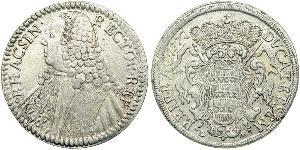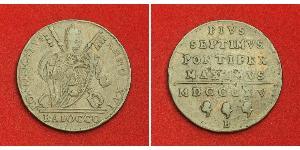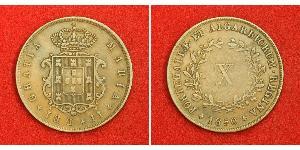(sold for $10.0)
1793, Mainz (French Occupation). Scarce Copper 2 Sols Coin. (VF-) Siege Issue!
Denomination: 2 Sols Mint Place: Mainz (Germany) References: KM-602 ($55 in F!). Mint year: 1793 (Year 2 of the Revolution) Condition: Heavy weight-adjusting marks in obverse, uneven toning and minor environmental damage, crudely struck otherwise VF+ Material: Copper Diameter: 25mm Weight: 7.07gm
Obverse: Value numeral (2) flanked by rosettes above denomination (SOLS) and another rosette. Legend: MONOYE DE SIEGE DE MAYENCE ("Siege coin of Mainz city.") Reverse: Fasces topped by cap of liberty within wreath. Legend: REPUBLIQUE FRANCAISE / 1793 L'AN 2e
em>.
In the Siege of Mainz (German: Belagerung von Mainz), from 14 April to 23 July 1793, a coalition of Prussia, Austria, and other German states besieged and captured Mainz from revolutionary French forces. The allies, especially the Prussians, first tried negotiations, but this failed, and the bombardment of the city began on the night of 17 June.
Within the town the siege and bombardment led to stress between citizens, municipality and the French war council, governing since 2 April. The city administration was displaced on 13 July; this increased the stubbornness of the remaining population. Since a relief army was missing, the war council was forced to take up negotiations with the allied forces on 17 July; the remaining soldiers capitulated on 23 July.
Nearly 19,000 French troops surrendered at the end of the siege, but were allowed to return to France if they promised not to fight against the allies for one year. Consequently they were used to fight French royalists in the Vendée region of France. They left the town singing La Marseillaise (also known as the Chant de guerre de l'Armée du Rhin).
The Republic of Mainz, the first democratic state on the later German territory, was subsequently dissolved. Mainz received a Prussian commander to administer the city. The bombardment had left devastating traces in the townscape: some civil buildings and aristocratic palaces, the electoral pleasure palace Favorite, the House of the Cathedral Provost, Liebfrauen- and the church of Society of Jesus had been destroyed, as well as St. Crucis, the Benedictine abbey St. Jacob on the citadel and the remains of St. Alban's Abbey. The cathedral had been heavily damaged.
The biggest impact of the occupation and siege was that the city's part in the old imperial electoral structure finally came to their end. Thus the events of the year 1793 also marked the end of Aurea Moguntia, the Latin nickname for the city: "Golden Mainz". The city lost its status as the electoral residence.
The shelling of Mainz was widely discussed in Europe. Many people gathered round the town in order to view the siege. Johann Wolfgang von Goethe assisted Duke Carl August of Saxe-Weimar during the siege and wrote a famous book about it.

|
Posted by:
anonymous 2018-04-18 |
1 Ruble USSR (1922 - 1991) Copper/Nickel
group has 3 coins / 3 prices
⇑















-300-150-0LTBwcI0tu0AAAEqRlpDRaWP.jpg)







